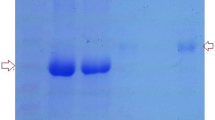Abstract
Anticryptococcal activity of human serum and apotransferrin in RPMI 1640 was studied in vitro. The effects of varying concentrations of FeCl3 on this activity was investigated. Possible synergy of serum and apotransferrin with fluconazole was also measured. The fungistatic activity of human serum, whether lyophilized, stored at 4 °C, fresh frozen or purchased from commercial sources vs. Cryptococcus neoformans was comparable. There was no significant loss of fungistatic activity after freezing and thawing the serum up to 10 times. The fungistatic activity of human serum was similar when tested in different tissue culture media with the exception of Medium 199. The addition of apotransferrin (2.0 or 0.2 mg/ml) to RPMI 1640 had an inhibitory effect on cryptococcal growth. This effect was reversed by 20 μM of FeCl3 at both apotransferrin concentrations. By contrast, addition of FeCl3 to human serum and RPMI 1640 did not reverse inhibition of growth. Fluconazole synergized with the human serum preparations described, but not with pooled commercial serum, for fungicidal activity. Synergistic activity of fluconazole and human serum was not affected by the addition of FeCl3. Apotransferrin did not show any synergistic fungicidal activity with fluconazole.
Similar content being viewed by others
References
Anonymous. Cryptococcosis and AIDS. Lancet 1988; 1: 1434–1436.
Howard DH. Some factors which affect the initiation of growth of Cryptococcus neoformans. J Bacteriol 1961; 82: 430–435.
Baum GL, Artis D. Characterization of the growth inhibition factor for Cryptococcus neoformans in human serum. Am J Med 1963; 87: 53–57.
Szilagyi G, Reiss F, Smith JC. The anticryptococcal factor of blood serum. J Invest Dermatol 1966; 46: 306–308.
Igel JH, Bolande RP. Humoral defense mechanism in cryptococcosis: Substances in normal human serum, saliva, and cerebrospinal fluid affecting the growth of Cryptococcus neoformans. J Inf Dis 1966; 116: 75–83.
Esterly NB, Brammer SR, Crounse RG. The relationship of transferrin and iron to serum inhibition of Candida albicans. J Invest Dermatol 1967; 49: 437–442.
Bennett JE, Grant S (eds). Fluconazole: an Overview. Langhorne, Pennsylvania: ADIS Press International, 1990: 82 pp.
Nassar F, Brummer E, Stevens DA. Different components in human serum inhibit multiplication of Cryptococcus neoformans and enhance fluconazole activity. Antimcrob Agents Chemother 1995; 39: 2490–2493.
Author information
Authors and Affiliations
Corresponding author
Rights and permissions
About this article
Cite this article
Grover, D.D., Brummer, E. & Stevens, D.A. Study of the role of iron in the anticryptococcal activity of human serum and fluconazole. Mycopathologia 133, 71–77 (1996). https://doi.org/10.1007/BF00439116
Accepted:
Issue Date:
DOI: https://doi.org/10.1007/BF00439116




